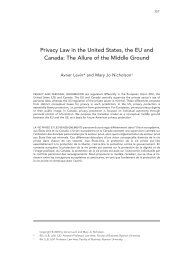The Criminal Phenomenon on the Internet: Hallmarks of ... - uoltj
The Criminal Phenomenon on the Internet: Hallmarks of ... - uoltj
The Criminal Phenomenon on the Internet: Hallmarks of ... - uoltj
You also want an ePaper? Increase the reach of your titles
YUMPU automatically turns print PDFs into web optimized ePapers that Google loves.
(2008) 5:1&2 UOLTJ 125<str<strong>on</strong>g>The</str<strong>on</strong>g> <str<strong>on</strong>g>Criminal</str<strong>on</strong>g> <str<strong>on</strong>g>Phenomen<strong>on</strong></str<strong>on</strong>g> <strong>on</strong> <strong>the</strong> <strong>Internet</strong> 129computer crime, at a time when <strong>the</strong> internet was not as widespread as it ispresently. Wasik c<strong>on</strong>centrated <strong>on</strong> <strong>the</strong> characteristics and classificati<strong>on</strong>s <strong>of</strong>perpetrators as well. 9 Levins<strong>on</strong> sorted categories <strong>of</strong> cyber threats into fivegroups: insiders, hackers, virus writers, criminal groups, and terrorists. 10 Reynoldsclassified perpetrators into hacker, cracker, insider, industrial spy, cybercriminaland cyberterrorist. 11 That is to say, <strong>the</strong> widespread use <strong>of</strong> computers created amulti-dimensi<strong>on</strong>al social envir<strong>on</strong>ment that allowed potential computer criminalsto discover new opportunities for attack.<strong>Internet</strong> users worldwide are str<strong>on</strong>gly sex divided; that is, a higherpercentage <strong>of</strong> males than females use <strong>the</strong> internet. For example, in 2001, womenmade up 6 percent <strong>of</strong> internet users in <strong>the</strong> Arab states, 38 percent in LatinAmerica, 25 percent in <strong>the</strong> EU, 37 percent in China, 19 percent in Russia, 18percent in Japan, 17 percent in South Africa, and nearly 50 percent in <strong>the</strong> UnitedStates. 12 However, <strong>the</strong> gender gap is narrowing, with females c<strong>on</strong>stituting <strong>the</strong>majority <strong>of</strong> internet users in some countries. In Nordic countries, it was found thatmen c<strong>on</strong>stitute a higher percentage <strong>of</strong> daily users <strong>of</strong> <strong>the</strong> internet than women. 13Previous studies showed that cybercrime is far more sex divided than internetuse. According to Levins<strong>on</strong>, “[i]t is well established that boys commit far morejuvenile crime, particularly violent crime, than girls.” 14 Cybercrime seems lessviolent, but <strong>the</strong> research indicates that more males commit cybercrimes thanfemales. According to Jiang, males c<strong>on</strong>stitute 91.45 percent <strong>of</strong> <strong>the</strong> perpetrators,while females c<strong>on</strong>stitute <strong>on</strong>ly 8.55 percent. 15 He suggested that this was <strong>the</strong>result <strong>of</strong> differences between males and females in computer knowledge andskills combined with attitudes in <strong>on</strong>line interacti<strong>on</strong>s. However, <strong>the</strong> reas<strong>on</strong>s whyfemales are found guilty <strong>of</strong> cybercrime less <strong>of</strong>ten than males are not clear atall. Specific research is needed to address <strong>the</strong> following questi<strong>on</strong>s: Do womencommit less cybercrime? Are cybercrimes committed by women less likely tobe detected? More philosophically, can we measure this criminal phenomen<strong>on</strong>am<strong>on</strong>g men and women using <strong>the</strong> same c<strong>on</strong>cept? But this study is not intendedto answer <strong>the</strong>se questi<strong>on</strong>s.A noteworthy phenomen<strong>on</strong> is that whe<strong>the</strong>r it be individual cybercrime,corporate cybercrime, or organized cybercrime, young perpetrators play acritical part. Although <strong>the</strong>re is no age limit to commit cybercrime, we foundthat, similar to traditi<strong>on</strong>al crimes, youth c<strong>on</strong>stitute an important proporti<strong>on</strong> <strong>of</strong><strong>the</strong> cybercriminals. As LR Shann<strong>on</strong> reported, in 1993, cybercriminals tend to bebetween <strong>the</strong> ages <strong>of</strong> 14 and 30; <strong>the</strong>y are usually bright, eager, highly motivated,adventuresome and willing to accept technical challenges. 16 <str<strong>on</strong>g>The</str<strong>on</strong>g> age <strong>of</strong> criminalresp<strong>on</strong>sibility varies from nati<strong>on</strong> to nati<strong>on</strong>. In most countries, children younger9. Martin Wasik, Crime and <strong>the</strong> Computer (Oxford University Press 1991) at pp. 60–65.10. David Levins<strong>on</strong>, ed., Encyclopedia <strong>of</strong> Crime and Punishment, vol. 2. (Sage Publicati<strong>on</strong>s, 2002) at p. 525.11. George Reynolds, Ethics in Informati<strong>on</strong> Technology (Thoms<strong>on</strong> Course Technology 2003) at pp. 58-65.12. Women’s Learning Partnership, “Technology Facts & Figures,” (December 2001),.13. Nordic Council <strong>of</strong> Ministers, “Nordic Informati<strong>on</strong> Society Statistics 2005,” Report, at p. 42.14. Levins<strong>on</strong>, Encyclopedia, supra note 10 at p. 490.15. Ping Jiang, A Study <strong>of</strong> Computer Crime (Shang wu yin shu guan, 2000) at pp. 151–152.16. LR Shann<strong>on</strong>, “<str<strong>on</strong>g>The</str<strong>on</strong>g> Happy Hacker,” review <strong>of</strong> Paul Mungo and Bryan Clough, Approaching Zero: <str<strong>on</strong>g>The</str<strong>on</strong>g>Extraordinary Underworld <strong>of</strong> Hackers, Phreakers, Virus Writers, and Keyboard <str<strong>on</strong>g>Criminal</str<strong>on</strong>g>s (Random House, 1993),(21 March 1993) <str<strong>on</strong>g>The</str<strong>on</strong>g> New York Times G 16, .









